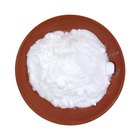Xanthan gum, first discovered in the 1950s by USDA scientist Allene Jeanes, is a natural substance produced by the bacteria Xanthomonas campestris. It is an ingredient in many commercial sauces, salad dressings and ice cream, and is a staple in the pantry of those who cannot tolerate gluten. This excellent thickening agent is widely available in health food stores, and you can use it to thicken soup without worrying about changing the soup's flavor.
Hot or Cold
Some thickeners will not dissolve in cold soups, while others begin to get too thick as soon as you remove them from a source of heat, resulting in a soup that can seem more like a gravy. One property that makes xantham gum an excellent soup thickener is its ability to thicken regardless of temperature. You can use it in gazpacho or chicken noodle soup, and it will retain its viscosity.
A Little Goes a Long Way
Xanthan gum is an extremely effective thickener -- you just need a little, and it doesn’t affect the taste of your soup. Most recipes call for only 1 teaspoon in place of each tablespoon of flour or cornstarch. Put another way, you’ll need about 1/8 teaspoon for 1 cup of liquid. For such a small amount, digital scales are more accurate than volume measurements. Flour and cornstarch typically require much higher proportions to achieve the same thickness. Delicately-flavored asparagus soup can be overwhelmed by the addition of flour, but you won't taste the small amount of xanthan gum.
Silky Texture
Often added to commercial ice cream to improve the texture and give it a creamy smoothness, xanthan gum will do the same for your soup. If you're cutting back on calories, you can use xanthan gum to replace at least some of the cream in cream-based soups.
It's All in the Technique
When adding xanthan gum to soup, it helps to mix it with a little warm liquid first. Dissolve the appropriate amount into a little bit of soup, whisk until it's well blended, then add it back to the soup pot. If you add dry xanthan gum directly to the soup, you might get clumps. Continue stirring until it's completely incorporated.
Related Articles

Do You Use Flour or Corn Starch to ...

Substitute for Manioc Starch

How to Make Crab Bisque

How to Keep Milk From Separating in ...

How to Make Potato Hamburger Soup

How to Substitute Potato Starch for ...

How to Make French Sauce With Roux of ...

How to Make a Cream Soup Without ...

What Can I Substitute for Cornstarch?
Can You Substitute Cornstarch for Flour?

How to Thicken a Watery Beef Stew

Preservatives in Campbell's Soups

How to Get Rid of the Acid Taste in ...

How to Reduce Chicken Stock to a Third
Can I Freeze Split Pea Soup With Ham ...
Can I Cold Pack and Can Homemade Soup?

What Can I Use Instead of Cream of ...

How to Cut the Acidity of Vegetable Soup

How to Make Celery Soup

Low Sodium Substitute for Condensed ...
References
Writer Bio
Leslie Darling has been a writer since 2003, writing regularly for "Mississippi Magazine" and "South Mississippi Living," specializing in food and wine, animals and pets, and all things Southern. She is a graduate of the University of New Orleans.